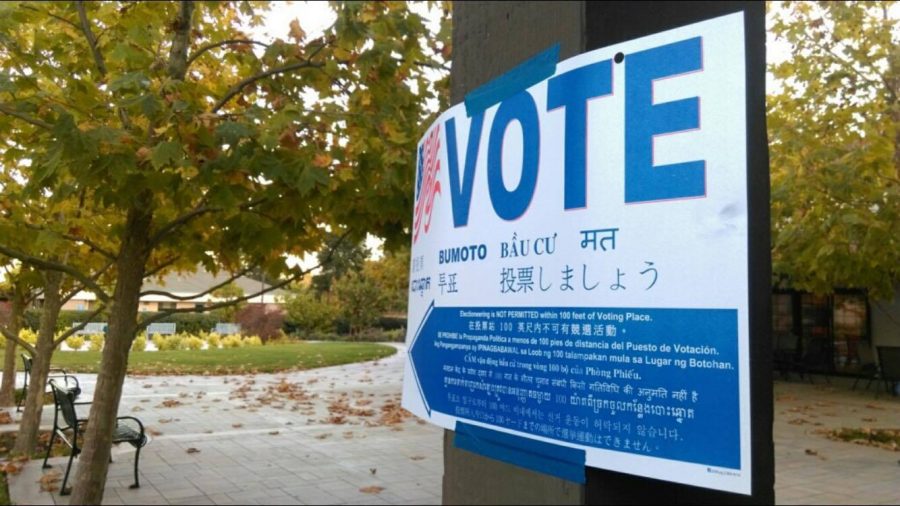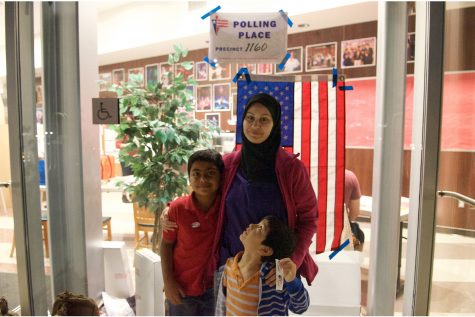Donald Trump wins 2016 presidential election
November 8, 2016
Donald John Trump wins the 2016 presidential election, beating out Hillary Clinton 276 electoral votes to 218 votes, as of 12:15 a.m. on Nov. 9.
Minutes before midnight on Nov. 8, Trump gave a speech at his campaign headquarters in New York City following a speech from his Vice President Mike Pence. He talked about receiving a call from opponent Hillary Clinton and congratulated her for her work, thanked his family and supporters and outlined some of his plans for the country as president.
Donald Trump won key swing states such as Ohio, Michigan and Florida and is the first Head of State that has never had any previous political experience. He is currently 70 years old and was listed by Forbes as the 156th wealthiest person in the world in 2016.
Trump’s real estate career began at his father’s company and from there he expanded to hotels, casinos, golf courses, professional sports teams, and an university. He has also had appearances in multitudes of reality TV shows.
His campaign started in June 2015, when he announced his candidacy for the Republican presidential nomination. He was formally nominated in July 2016 at the Republican National Convention.
Live election updates
A sign near a polling location for the 2016 presidential elections bears instructions in many languages. According to the Census Bureau, 43 percent of eligible voters 18 to 29 voted that year.
Harker Aquila will update this article as results are announced across the United States.
9:10 p.m.: Trump has taken Iowa as per CNN.
9:07 p.m.: Trump just won Utah as per the Washington Post.
8:48 p.m.: Trump has taken Georgia according to the Washington Post.
8:40 p.m.: Clinton has just taken Washington according to Washington Post.
8:33 p.m.: Clinton has taken Washington according to CNN and NBC News.
8:12 p.m.: Trump has taken North Carolina according ABC News.
8:06 p.m.: Clinton has taken California, Hawaii and Oregon, and Trump has taken Idaho. The current electoral count is Clinton’s 197 to Trump’s 201.
7:52 p.m.: Donald Trump has taken Florida with 4.757 million popular votes to Clinton’s 4.441 according to The Washington Post.
7:42 p.m.: Clinton has taken Virginia as well as Colorado according to The Washington Post.
7:28 p.m.: According to CNN, The New York Times, and NBC, Trump has taken Ohio with 2.336 million popular votes to Clinton’s 1.853 million.
7:15 p.m.: Trump has taken Missouri as well as Montana. Clinton has won New Mexico.
6:41 p.m.: Clinton has taken Connecticut.
6:16 p.m.: Trump has taken Texas.
6:09 p.m.: Clinton has taken New York.
6:05 p.m.: Trump has taken Kansas, Oklahoma, Nebraska, and Louisiana.
6:00 p.m.: Trump has just taken North Dakota, South Dakota, Mississippi, Arkansas, and Wyoming. Clinton has taken Illinois.
5:31 p.m.: Trump has just won Alabama and South Carolina.
5:20 p.m.: Hillary Clinton is leading Michigan as well as Ohio. Trump has now taken the lead from Clinton in Florida.
5:06 p.m.: Hillary Clinton has just won New Jersey and Delaware.
4:30 p.m.: Donald Trump has won Indiana, Kentucky, and West Virginia thus far. Hillary Clinton has won Vermont with 1578 votes to Trump’s 1345. The country awaits results from Ohio.
Upper school teacher casts first vote as U.S. citizen
Upper school chemistry teacher Dr. Mala Raghavan voted for the first time after becoming a U.S. citizen. Watch an interview with her, in which she describes why she became a citizen, why she is voting and much more.
Interviews with people at the polls
Ayesha Mohammed, dentist and mother of three: “I would say try to learn as much as you can about the candidates, not all candidates will align perfectly with all of your views, but you need to try and vote for the candidate who you think will serve the country the best.”
International nations and leaders react to presidential election
The candidate that succeeds President Barack Obama in the presidency will also succeed the authority to control America’s international relations with key nations the U.S. is involved with.
Democratic presidential candidate Hillary Clinton and Republican presidential candidate Donald Trump differ in terms of which countries have preexisting relationships with these individuals and which nations have been previously associated with these candidates.
Clinton’s experience as Secretary of State has given her an opportunity to interact with many nations. She dealt with Middle Eastern nations such as Iraq, Iran and Syria as she was in office during the Arab Spring protests in 2011, the making of the Iran nuclear deal and the placement and withdrawal of troops in nations such as Iraq.
“When you look at Clinton, since she served as Secretary of State, she already has a pre-existing relationship with most countries around the world,” AP U.S. Politics and Government teacher Carol Green said. “Most countries already recognize her, most of them are comfortable with her and in most places she has a considerable fanbase. I think you end up having positive relations or at least stable relations.”
However, not all of Clinton’s implemented policies and actions as Secretary of State have been favorable in the eyes of U.S. citizens.
“There wasn’t much that was done well with Clinton as Secretary in terms of foreign relations, especially the Middle East, North Korea [and] Iran,” Robert Varich, vice chair of the the executive committee of the Santa Clara Republican party, said. “Nothing went right, and I’m not saying that from a perspective of the conservative side, I’m saying why did we give so many billions to Iran, why did we trade money for hostages?”
Certain world leaders have shown support for Clinton, including current president Obama.
“She doesn’t just talk the talk she walks the walk. She’s got plans and she’s got details. And she’s read them through and she’s thought them through,” Obama said during a speech at the University of Central Florida.
Meanwhile, Trump has emphasized the tightening of American borders in order to make it a safer country and has proposed future policies to include a wall between the United States and Mexico to prevent illegal immigration.
“With Trump, I think we saw a little of [his proposed policies] when he talked to Mexico; he came and said the meeting with the president of Mexico was a good meeting, and the Mexican president said it was a good meeting,” Varich said. “When they got further away, he said they were paying for the wall, so we’re probably going to have some growing problems.”
World leaders have publicly expressed their opinions on the Republican candidate. Canadian prime minister Justin Trudeau opposes Trump’s notion of the border wall between America and Mexico.
“Ultimately, being open and respectful towards each other is much more powerful as a way to diffuse hatred and anger than, you know, layering on, you know, big walls and oppressive policies,” Trudeau said in an interview for “60 minutes” with Lara Logan.
Citizens and leaders from areas such as the United Kingdom and the Middle East have expressed similar views about Trump.
In contrast, Russian president Vladimir Putin has maintained a friendly relationship with Trump, though officials in Moscow have been cautious about overtly voicing support for him. Additionally, Trump has garnered a significant amount of support in China.
In terms of international trade, Trump has made several statements against current trade agreements, and he plans to withdraw from the Trans-Pacific partnership (TPP) and to renegotiate terms with countries in the North Atlantic Free Trade Agreement (NAFTA) to ensure better trade deals for the U.S.
Meanwhile, Clinton has favored a multilateral trade agreement. However, she withdrew support for the TPP, stating that the agreement did not meet her expectations for a trade agreement.
Harker alumni campaigners speak out against third party protest voters
Harker alumni campaigners speak out against third party protest voters .With many voters dissatisfied with presidential candidates Donald Trump and Hillary Clinton, some have turned to protest voting, electing to check the boxes of third-party candidates rather than surrender their ballots to either candidate.
Aside from Trump for the Republicans and Clinton for the Democrats, three other relatively known candidates, Gary Johnson of the Libertarian Party, Jill Stein of the Green Party and Evan McMullin, an independent, grace the 2016 presidential election ballot.
However, some believe protest voting usually ends up becoming a vote with the opposite effect of what the voter had intended.
Sahana Narayanan (‘16) is a part of the Columbia University College Democrats, a student political organization on campus, and she worked at the Hillary Clinton Campaign headquarters in coordination with the Pennsylvania State Democratic Party.
“Talking to a lot of the people this weekend who said they were not going to vote for a third-party like Gary Johnson, we actually had to tell them not voting or voting for a third-party was a vote for Trump,” Narayanan said. “By voting for the other party, you are voting for someone with your opposite viewpoints.”
Some states have seen considerable support for Johnson from voters of all ages, which is especially significant in those states with very close Trump and Hillary support projections.
“Looking at the results right now, there are states where Johnson has some support, and it’s a little disheartening because in those states, Trump and Hillary are close and I think [the votes that Johnson would win] can make a difference,” Narayanan said.
In a poll of upper school students conducted by Harker Aquila, 79.5 percent of students knew what protest voting was, but only 34.2 percent believed that protest voting will have a tangible effect on the election.
“Protest voting is not an efficacious means of raising awareness. It should only come from those who otherwise would not engage in the political process,” Annie Zhou (‘16) said. “Given the bipartisan nature of politics in the United States, protest voting has an effect on the election in that it siphons votes away from heavyweight candidates. Basically, if you’re planning on protest voting, given how close it is, just don’t.”
In a two-party political system like that of the United States, voting for a third-party candidate almost always is the equivalent of not voting at all.
“There [are] two major parties and I think that [choosing another party] is really shortsighted view,” Michael Haider, who participated in the Santa Clara poll, said. “In my opinion, this election, neither candidate was really qualified to become President of the United States, but you have to make a choice. Unfortunately, this is what happened this time but hopefully, it doesn’t happen again.”


